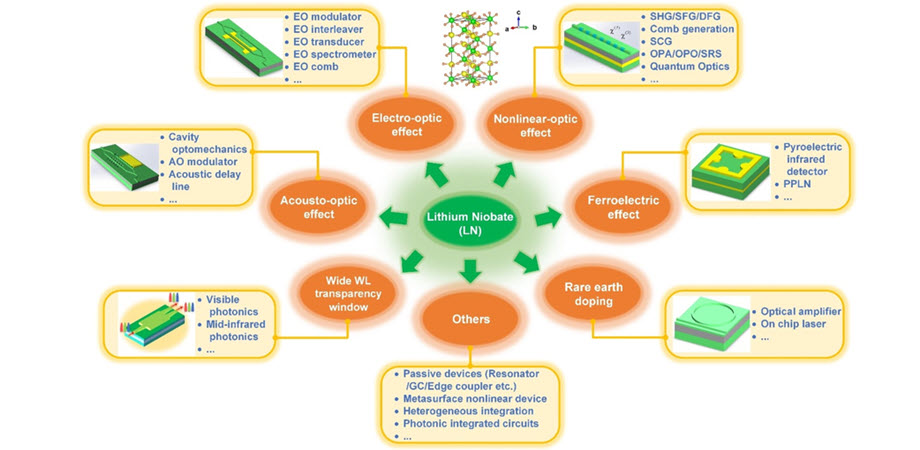Advances in lithium niobate photonics

Lithium niobate (LiNbO3, LN) is one of the most important artificial materials and has been widely used in the photonics area since it was firstly discovered to have a ferroelectric property in 1949. Compared with other material systems, LN has various superior characteristics, such as a wide transparency window (400 nm to 5 m), large electro-optic (EO)/nonlinear-optic (NLO)/acousto-optic (AO)/pyroelectric coefficients, as well as stable chemical and physical properties. Based on these effects, various kinds of photonic devices have been demonstrated. For example, the large EO property of LN can be used for the realization of high-speed modulators.
In typical bulk LN (planar devices), light is confined inside a planar waveguide formed by ion-in diffusion or proton exchange. In such a method, the refractive index contrast is usually very small (~ 0.02), therefore bulk LN based devices have a large feature size and relatively poor performance even though they have been successfully used for decades. The problem of poor index contrast hampers further development of LN photonics as high power and large device sizes are not compatible with desired trends in energy efficiency and integration.
This situation may yet change, though, as high-quality thin film LN (TFLN) with controlled thickness has become available through the lapping and polishing and crystal ion slicing (CIS) methods. These high quality TFLNs can be bonded onto an insulator with a lower refractive index (such as silicon oxide), and then an LN on insulator (LNOI) structure similar to silicon on insulator (SOI) is realized.
The principal benefit from the large refractive index contrast of LNOI is that much more compact devices can be integrated on the same single chip by patterning structures using various developed etching technologies. In addition, TFLN can also be bonded to other material platforms which are lithographically patterned, where LN serves as a thin layer of unpatterned film and the light from waveguides or devices fabricated in the bonded platform interact with it. Relying on developed processing technologies, LN based photonic devices with high-performance, especially integrated devices, have experienced rapid development in recent years and many different structures for various application scenarios have been demonstrated. An era of LN photonics is coming.
Researchers from the National University of Singapore (NUS), Huazhong University of Science and Technology (HUST), Agency for Science, Technology and Research (A*STAR), and Nanyang Technological University (NTU) recently summarized advances in LN photonics in detail. The content of this review, published in Advanced Photonics, includes the integrated LN photonics devices which have appeared in recent years, as well as selected bulk LN based devices and related processing technologies. In this way, the research community can reach a better, comprehensive understanding of the technology evolution of LN photonics.
On behalf of his team and the rapidly advancing field of research, Aaron J. Danner, NUS associate professor and senior author of the work, hopes readers may be inspired by this work and then contribute to the further development of LN photonics. He offers a summary of the work in the following video:
Read the Gold Open Access article by G. Chen et al., “Advances in lithium niobate photonics: development status and perspectives,” Adv. Photon. 4(3) 034003 (2022), doi 10.1117/1.AP.4.3.034003.
| Enjoy this article? Get similar news in your inbox |
|



